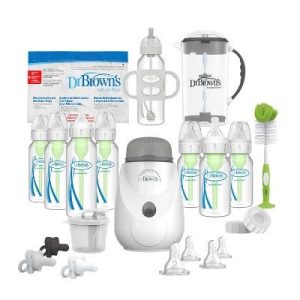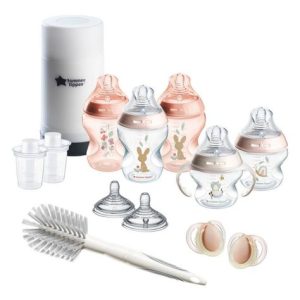Bottle feeding can be a wonderful way to nourish your baby. It allows for bonding time and provides essential nutrients for healthy growth. However, proper positioning during bottle feeding is crucial for your baby’s comfort and safety. Wrong bottle-feeding positions can lead to choking, ear infections, and gas.
This article explores essential tips for safe and comfortable bottle feeding, emphasizing the importance of proper positioning.
Understanding Proper Bottle Feeding Positioning
Here’s a breakdown of key elements for safe bottle-feeding posture:
Cradle hold:
Cup your baby’s head in the crook of your arm, supporting their neck and shoulders. This position keeps your baby’s head slightly elevated.
Body support:
Ensure your baby’s entire body is well-supported, either in your arms or a reclining infant seat. Avoid propping your baby with pillows or blankets.
Bottle angle:
Hold the bottle at an angle that keeps the nipple filled with formula throughout feeding. Tilting the bottle too much can cause your baby to swallow air.
Nipple placement:
The entire nipple should be in your baby’s mouth, not just the tip. Gently guide your baby’s mouth to the nipple.

Common Positioning Mistakes and Why They Matter
- Flat on the back: Never lay your baby flat on their back for bottle feeding. This can cause choking if they inhale formula.
- Propping with pillows: Using pillows or blankets to prop your baby in a sitting position is unsafe. It can lead to suffocation and airway blockage.
- Straining to reach the bottle: Your baby’s neck muscles are still developing. Don’t force them to hold their head up or bend excessively to reach the bottle.
Additional Tips for Safe and Comfortable Bottle Feeding
Here are some additional practices to promote safe and enjoyable bottle-feeding experiences:
- Pace feeding: Take breaks during feeding to allow your baby to swallow and breathe. Look for signs your baby is full, such as turning away from the bottle or closing their mouth.
- Burping: Burp your baby halfway through and after each feeding. This helps release swallowed air and prevents gas discomfort.
- Bonding time: Make eye contact and talk to your baby during feeding. Bottle feeding can still be a warm and nurturing experience.

When to Seek Professional Guidance
If you have any concerns about bottle feeding your baby, consult your pediatrician or a lactation consultant. They can address your specific questions and provide personalized guidance on safe feeding practices.
Remember, the most important thing is your baby’s health and safety. By following these tips and recommendations, you can ensure a comfortable and positive bottle-feeding experience for both you and your baby.
Creating a Comfortable Feeding Environment
Here are some ways to create a calm and comfortable environment for bottle feeding:
- Choose a quiet and well-lit space. Avoid distractions like loud noises or bright lights.
- Maintain a comfortable temperature. A warm room can help relax your baby.
- Cuddle your baby close. Skin-to-skin contact can be calming for both you and your baby.

Feeding Cues and Responsiveness
- Look for hunger cues. Your baby will show signs they’re hungry, such as rooting (turning their head towards your touch), sucking motions, and fussiness.
- Respond to your baby’s cues. Don’t force your baby to finish the entire bottle. Pay attention to signs they’re full, like turning away or closing their mouth.
Cleaning and Sterilization
- Wash your hands thoroughly with soap and warm water before each feeding.
- Clean and sterilize bottles and nipples according to the manufacturer’s instructions. This helps prevent the spread of bacteria.
- Store clean bottles and nipples in a covered container to keep them dust-free.
By following these tips and using proper positioning, you can ensure a safe and positive bottle-feeding experience for your baby.
Remember, every baby is different. If you have any questions or concerns about bottle feeding, consult your pediatrician or a lactation consultant. They can provide personalized guidance and address your specific needs.

Special Considerations for Bottle Feeding
-
Premature babies: If your baby was born premature, they may have specific feeding needs. Consult your pediatrician for guidance on safe and appropriate bottle-feeding positions for your baby.
-
Multiples: Feeding twins or triplets can be a challenge. There are special feeding pillows and positions that can help you comfortably bottle-feed multiple babies at once. Talk to your pediatrician or a lactation consultant for recommendations.
-
Traveling: Bottle feeding on the go can be easier than breastfeeding. However, it’s still important to find a safe and comfortable space to feed your baby. Look for clean surfaces and avoid bottle feeding in a moving car.
Remember, the most important thing is your baby’s health and safety. By following these tips and recommendations, you can ensure a comfortable and positive bottle-feeding experience for both you and your baby.
Enjoy this special bonding time with your little one!
Additional Bottle-Feeding Positions for Comfort
Here are some variations of the cradle hold you can try for added comfort:
-
Semi-upright position: You can sit your baby up on your lap with their back against your chest or stomach. This position can be helpful for babies with reflux.
-
Football hold: This position is similar to how a football player carries the ball. Tuck your baby’s arm closest to you under their armpit, cradling their head with your hand. This position can be helpful for babies with gas.
Remember, the best bottle-feeding position is the one that feels most comfortable and natural for you and your baby.
Here are some additional tips for a smooth feeding experience:
- Pace feeding: Take breaks during feeding to allow your baby to swallow and breathe. Look for signs your baby is full, such as turning away from the bottle or closing their mouth.
- Burping: Burp your baby halfway through and after each feeding. This helps release swallowed air and prevents gas discomfort.
By following these tips and using proper positioning, you can ensure a safe and positive bottle-feeding experience for your baby.
Remember, every baby is different. If you have any questions or concerns about bottle feeding, consult your pediatrician or a lactation consultant. They can provide personalized guidance and address your specific needs.

